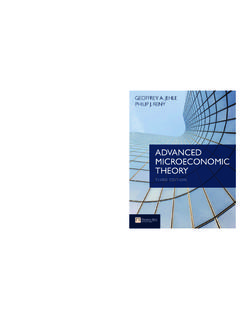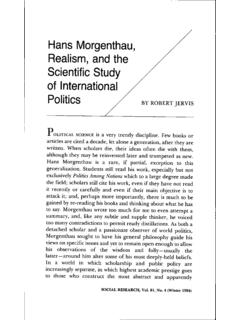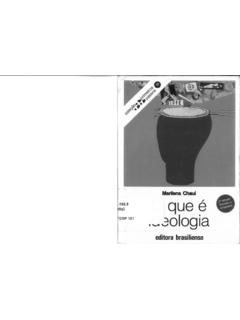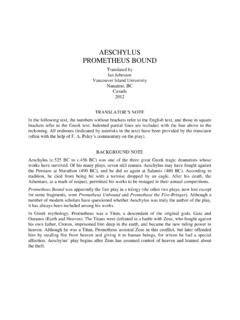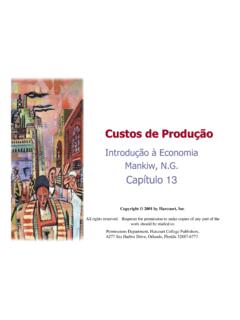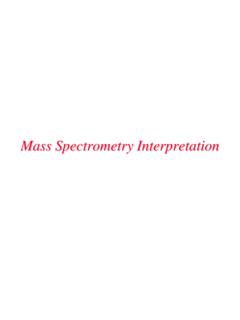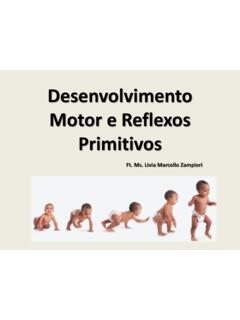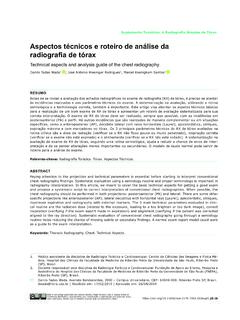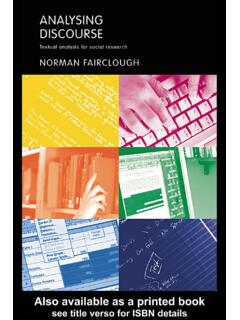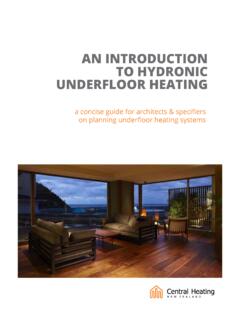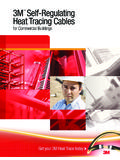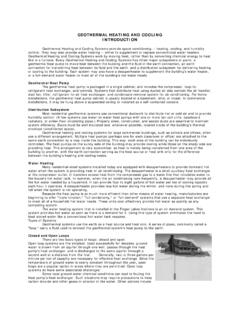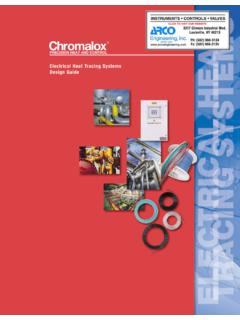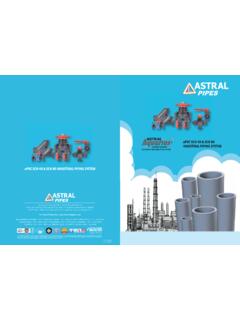Transcription of Fundamentals of Heat and Mass Transfer
1 This pageintentionally leftblankCopyright 2006, 1999, 1994, New Age International (P) Ltd., PublishersPublished by New Age International (P) Ltd., PublishersAll rights part of this ebook may be reproduced in any form, by photostat, microfilm,xerography, or any other means, or incorporated into any information retrievalsystem, electronic or mechanical, without the written permission of the inquiries should be emailed to FOR ONE WORLDNEW AGE INTERNATIONAL (P) LIMITED, PUBLISHERS4835/24, Ansari Road, Daryaganj, New Delhi - 110002 Visit us at (13) : 978-81-224-2642-7 Professor Obert has observed in his famous treatise on Thermodynamics that concepts arebetter understood by their repeated applications to real life situations. A firm conviction ofthis principle has prompted the author to arrange the text material in each chapter in thefollowing the first section after enunciating the basic concepts and laws mathematical modelsare developed leading to rate equations for heat Transfer and determination of temperaturefield, simple and direct numerical examples are included to illustrate the basic laws.
2 Morestress is on the model development as compared to numerical section titled SOLVED PROBLEMS comes next. In this section more involvedderivations and numerical problems of practical interest are solved. The investigation of theeffect of influencing parameters for the complete spectrum of values is attempted here. Problemsinvolving complex situations are shown solved in this section. Two important ideas are stressedin this section. These are checking of dimensional homogeneity in the case of all equationsderived and the validation of numerical answers by cross checking. This concept of validationin professional practice is a must in all design the next section objective type questions are given. These are very useful forunderstanding the basis and resolving the final section a large number of graded exercise problems involving simple tocomplex situations are the first of the 14 chapters the basic laws for the three modes of heat Transfer areintroduced and the corresponding rate equations are developed.
3 The use of electrical analogyis introduced and applied to single and multimode heat Transfer situations. The need for iterativeworking is stressed in the solved second chapter deals with one dimensional steady state conduction. Mathematicalmodels are developed by the three geometries namely Plate, Hollow Cylinder and Hollow insulation is also discussed. The effect of variation of thermal conductivity on heattransfer and temperature field is clearly brought out. Parallel flow systems are on variation of area along the heat flow direction are included. The use of electricalanalogy is included in all the worked examples. The importance of calculating the temperaturegradient is stressed in many of the the third chapter models for conduction with heat generation are developed for threegeometric configurations namely plate, cylinder and sphere. The effect of volume to surfacearea and the convection coefficient at the surface in maintaining lower material temperatureis illustrated.
4 Hollow cylindrical shape with different boundary conditions is with variable heat generation rate is also surface or conduction-convection situation is discussed in the fourthchapter. Models for heat Transfer and temperature variation are developed for four differentPREFACE TO THE THIRD EDITION boundary conditions. Optimisation of the shape of the fin of specified volume for maximumheat flow is discussed. Circumferential fins and variable area fins are analysed. The use ofnumerical method is illustrated. Error in measurement of temperature using thermometer iswell discussed. The possibility of measurement of thermal conductivity and convective heattransfer coefficient using fins is dimensional steady state conduction is discussed in the fifth chapter. Exact analysisis first developed for two types of boundary conditions. The use of numerical method is illustratedby developing nodal equations.
5 The concept and use of conduction shape factor is illustratedfor some practical dimensional transient (unsteady) heat conduction is discussed in Chapter 6. Threetypes of models arise in this case namely lumped heat capacity system, semi-infinite solid andinfinite solid. Lumped heat capacity model for which there are a number of industrialapplications is analysed in great detail and problems of practical interest are shown condition under which semi-infinite solid model is applicable as compared to infinite solidmodel is clearly explained. Three types of boundary conditions are analysed. Infinite solidmodel for three geometric shapes is analysed next. The complexity of the analytical solution isindicated. Solution using charts is illustrated in great detail. Real solids are of limiteddimensions and these models cannot be applied directly in these cases.
6 In these cases productsolution is applicable. A number of problems of practical interest for these types of solids areworked out in this section. In both cases a number of problems are solved using numericalmethods. Periodic heat flow problems are also and mechanism of convection are discussed in the seventh chapter. Afterdiscussing the boundary layer theory continuity, momentum and energy equations are the different methods of solving these equations are discussed. In addition to the exactanalysis approximate integral method, analogy method and dimensional analysis are alsodiscussed and their applicability is indicated. General correlations for convective heat transfercoefficient in terms of dimensionless numbers are arrived at in this Chapter 8, in addition to the correlations derived in the previous chapter, empiricalcorrelations arrived at from experimental results are listed and applied to flow over surfaceslike flat plate, cylinder, sphere and banks of tubes.
7 Both laminar and turbulent flows situationare through ducts is discussed in Chapter 9. Empirical correlations for various situationsare listed. Flow developing region, fully developed flow conditions, constant wall temperatureand constant wall heat flux are some of the conditions analysed. Flow through non-circularpipes and annular flow are also discussed in this convection is dealt with in Chapter 10. Various geometries including enclosedspace are discussed. The choice of the appropriate correlation is illustrated through a numberof problems. Combined natural and forced convection is also 11 deals with phase change processes. Boiling, condensation, freezing andmelting are discussed. Basic equations are derived in the case of freezing and melting andcondensation. The applicable correlations in boiling are listed and their applicability isillustrated through numerical 12 deals with heat exchangers, both recuperative and regenerative types.
8 TheLMTD and NTU-effectiveness methods are discussed in detail and the applicability of thesemethods is illustrated. Various types of heat exchangers are compared for optimising the radiation is dealt with in Chapter 13. The convenience of the use of electricalanalogy for heat exchange among radiating surfaces is discussed in detail and is applied inalmost all the solved problems. Gas radiation and multi-body enclosures are also 14 deals with basic ideas of mass Transfer in both diffusion and convectionmodes. A large number of problems with different fluid combinations are worked out in large number of short problems and fill in the blank type and true or false typequestions are provided to test the understanding of the basic pageintentionally leftblankCONTENTSP reface to the Third Editionv1AN OVERVIEW OF heat TRANSFER1 Transfer of heat Transfer Modes of heat Transfer and Units 11 Solved Problems11 Exercise Problems222 STEADY STATE CONDUCTION26 General Model for Conduction Study Conduction in One Direction (One Dimensional)
9 In Other Shapes Dimensional Steady State heat Conduction with Variable HeatConductivity or Variable Area Along the Section Thickness of Insulation Area Concept Flow 51 Solved Problems53 Objective Questions92 Exercise Problems933 CONDUCTION WITH heat GENERATION99 State One Dimensional Conduction in a Slab with Uniform HeatGeneration State Radial heat Conduction in Cylinder with Uniform heat Generation Conduction in Sphere with Uniform heat Generation 109 Solved Problems110 Objective Questions125 Exercise Problems125 VEDc-4\n-demo\tit ix4 heat Transfer WITH EXTENDED SURFACES (FINS)128 Model Calculation Flow Calculation Performance Fins and Plate Fins of Varying Sections with Radiation Surroundings Resistance Method 147 Solved Problems148 Objective Questions170 Exercise Problems1725 TWO DIMENSIONAL STEADY heat CONDUCTION176 to Differential Equation Method Method Analogy the Finite Difference Formulation 187 Solved Problems188 Exercise Problems1996 TRANSIENT heat CONDUCTION202 Wall Exposed to the Sun Parameter Model Infinite Solid heat Conduction heat Conduction in Large Slab of Limited Thickness.
10 Long Cylindersand Spheres Solution Method Method 233 Solved Problems234 Objective Questions278 Exercise Problems280xCONTENTSVEDc-4\n-demo\tit x7 CONVECTION285 of Convection Concept of Velocity Boundary Layer Boundary Layer and Turbulent Flow and Free Convection Used in Convection Studies Equation Method Analysis Methods of Experimental Results 307 Solved Problems308 Objective Questions331 Exercise Problems3328 CONVECTIVE heat Transfer PRACTICAL CORRELATIONS FLOW OVER SURFACES334 Over Flat Plates Flow Across Cylinders Across Spheres Over Bluff Bodies Across Bank of Tubes 360 Solved Problems363 Objective Questions380 Exercise Problems3819 FORCED CONVECTION385 Flow Boundary Layer Development Boundary Layer Flow Flow Metal Flow Through Non-circular Sections Variation of Temperature Along the Flow Direction 406 Solved Problems408 Objective Questions431 Exercise Problems432 CONTENTSxiVEDc-4\n-demo\tit xi10 NATURAL CONVECTION434 Nature of Flow Under Natural Convection Conditions of Analysis Method from Experimental Results More Recent Set of Correlations heat Flux Condition Vertical Surfaces Convection from Inclined Surfaces Cylinders Geometries Expressions for Air Free Convection in Enclosed Spaces Rotating Cylinders, Disks and Spheres Combined Forced and Free Convection 460 Solved Problems461 Objective Questions477 Exercise Problems47711 PHASE CHANGE PROCESSES BOILING.
